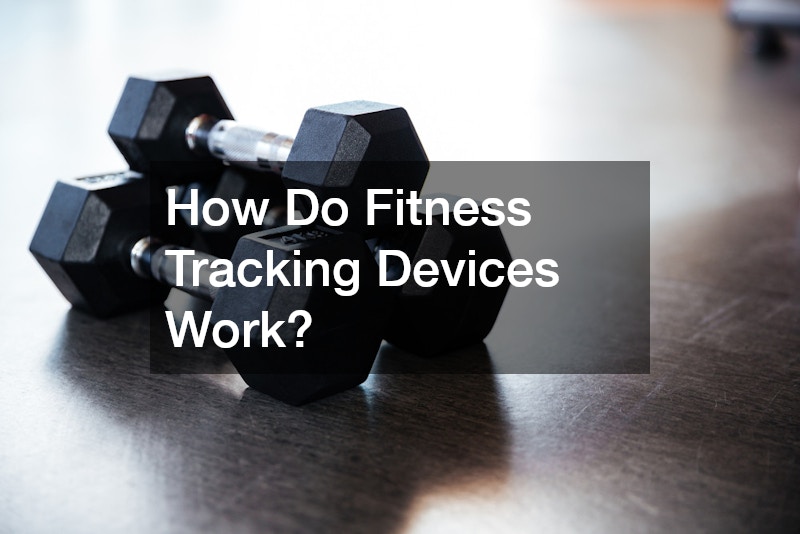Fitness tracking devices have revolutionized the way people approach their health and wellness goals. With advanced technology packed into sleek, wearable gadgets, these devices offer users an unprecedented insight into their physical activities. From counting daily steps to monitoring heart rate, these versatile tools support a comprehensive view of one’s fitness journey.
These wearables are designed to provide real-time data and feedback, which can help users make informed decisions about their health. They serve not only as motivators but also as personal coaches, allowing individuals to set and track goals with ease. With an array of sensors, fitness tracking devices transform everyday activities into quantifiable health metrics.
Whether you’re a newbie to the fitness world or a seasoned athlete, these devices cater to a wide range of fitness levels and needs. They seamlessly integrate with smartphones and other devices, offering users a cohesive experience to track progress over time. As technology advances, fitness trackers continue to evolve, adding more features and becoming even more indispensable.
Understanding the Core Components
At the heart of any fitness tracking device lies a collection of sophisticated sensors that gather data from the user’s body. These sensors typically include accelerometers, which detect motion and orientation, allowing the device to track steps accurately. In addition, many fitness trackers feature gyroscopes that help determine the device’s orientation, improving the precision of activity measurement.
Another crucial component is the heart rate monitor, which usually employs optical sensors to detect blood flow rate through the skin. This function provides users with crucial insights into their cardiovascular health and workout intensity. By measuring and analyzing heart rate patterns, wearables can offer personalized fitness recommendations based on the user’s activity level.
GPS sensors are also commonly found in these devices, especially those designed for outdoor activities like running or cycling. They provide detailed information about the user’s routes, speed, and elevation changes, enhancing the tracking capabilities of the device. Together, these sensors deliver a comprehensive picture of the user’s physical activity, helping to set realistic fitness goals.
How Fitness Trackers Measure Physical Activity
Fitness tracking devices work by collecting data on movement and physiological changes, which are then processed into understandable metrics. The accelerometer, one of the primary sensors, detects movement to track steps, distance, and even sleep patterns. Each motion is recognized and categorized, providing users with accurate data regardless of the activity they are performing.
In addition to movement tracking, these devices monitor exercise intensity through heart rate. By measuring beat-to-beat intervals, a fitness tracker can gauge how hard the body is working, offering data on calories burned and optimal workout zones. This information is valuable not only for daily activity tracking but also for ensuring workouts are effective and safe.
When GPS is enabled, the device records data about the user’s location and trajectory, which is especially useful for sports and fitness training. By mapping routes and calculating distances, users can visualize and analyze their outdoor activities. This feature adds a layer of functionality that integrates geographic information with personal fitness data.
Data Analysis and Feedback
The backbone of a fitness tracking device is its ability to analyze the collected data and provide meaningful feedback to the user. Complex algorithms process the data from multiple sensors, transforming raw figures into user-friendly information displayed through applications. This allows users to track progress, identify trends, and adjust their fitness routines accordingly.
Feedback mechanisms often include visual and audio cues that encourage users to meet their activity goals. For instance, achieving a daily step goal might trigger a celebratory notification, serving as both a motivator and a coach. These personalized insights are invaluable for users looking to maintain or improve their fitness levels.
Moreover, fitness tracking devices allow for data synchronization across various platforms, enabling comprehensive trend analysis over time. This connective capability means users can import, export, and share data across devices seamlessly. Whether it’s adjusting sleep patterns or improving workout routines, the information provided is actionable and adaptive.
Privacy Concerns and Security Measures
With the vast amount of personal data collected by fitness tracking devices, privacy and security concerns are paramount. These devices gather sensitive information—from location history to biometric data—that needs robust protection from unauthorized access. Manufacturers use encryption and secure methods of data transmission to ensure user privacy is maintained.
Fitness devices often require an account or app integration, where additional layers of security, like two-factor authentication, are employed. This heightened security helps prevent data breaches and unauthorized access, safeguarding users’ private information. Manufacturers are continuously improving these measures, adapting to the evolving landscape of cybersecurity threats.
As users, it’s important to remain proactive about data privacy by regularly updating device software and reviewing privacy settings. Users should also be mindful of third-party applications requesting access to fitness data and ensure these apps are reputable. Awareness and vigilance are key in keeping personal information secure while enjoying the benefits of these advanced tracking devices.
Fitness tracking devices have become integral tools for anyone serious about managing their health and fitness. By utilizing a range of sensors, they provide detailed insights into physical activity and health metrics. As these devices continue to evolve, they promise even more capabilities to enhance our understanding of personal health.
The convenience of having real-time data at one’s fingertips empowers users to make informed decisions and adjust their routines as necessary. Despite concerns over data privacy, with the right precautions, users can safely enjoy the comprehensive feedback these devices offer. From heart rate monitoring to GPS tracking, they serve as both a motivator and a guide on one’s fitness journey.
Embracing this cutting-edge technology can lead to improved health outcomes and a deeper awareness of how daily choices impact wellbeing. With the right fitness tracking device, anyone can transform their approach to fitness and lead a healthier lifestyle. As future advancements emerge, the role of these devices will only expand, providing even greater opportunities for personal health management.
Fitness tracking devices have revolutionized the way people approach their health and wellness goals. With advanced technology packed into sleek, wearable gadgets, these devices offer users an unprecedented insight into their physical activities. From counting daily steps to monitoring heart rate, these versatile tools support a comprehensive view of one’s fitness journey.
These wearables are designed to provide real-time data and feedback, which can help users make informed decisions about their health. They serve not only as motivators but also as personal coaches, allowing individuals to set and track goals with ease. With an array of sensors, fitness tracking devices transform everyday activities into quantifiable health metrics.
Whether you’re a newbie to the fitness world or a seasoned athlete, these devices cater to a wide range of fitness levels and needs. They seamlessly integrate with smartphones and other devices, offering users a cohesive experience to track progress over time. As technology advances, fitness trackers continue to evolve, adding more features and becoming even more indispensable.
Understanding the Core Components
At the heart of any fitness tracking device lies a collection of sophisticated sensors that gather data from the user’s body. These sensors typically include accelerometers, which detect motion and orientation, allowing the device to track steps accurately. In addition, many fitness trackers feature gyroscopes that help determine the device’s orientation, improving the precision of activity measurement.
Another crucial component is the heart rate monitor, which usually employs optical sensors to detect blood flow rate through the skin. This function provides users with crucial insights into their cardiovascular health and workout intensity. By measuring and analyzing heart rate patterns, wearables can offer personalized fitness recommendations based on the user’s activity level.
GPS sensors are also commonly found in these devices, especially those designed for outdoor activities like running or cycling. They provide detailed information about the user’s routes, speed, and elevation changes, enhancing the tracking capabilities of the device. Together, these sensors deliver a comprehensive picture of the user’s physical activity, helping to set realistic fitness goals.
How Fitness Trackers Measure Physical Activity
Fitness tracking devices work by collecting data on movement and physiological changes, which are then processed into understandable metrics. The accelerometer, one of the primary sensors, detects movement to track steps, distance, and even sleep patterns. Each motion is recognized and categorized, providing users with accurate data regardless of the activity they are performing.
In addition to movement tracking, these devices monitor exercise intensity through heart rate. By measuring beat-to-beat intervals, a fitness tracker can gauge how hard the body is working, offering data on calories burned and optimal workout zones. This information is valuable not only for daily activity tracking but also for ensuring workouts are effective and safe.
When GPS is enabled, the device records data about the user’s location and trajectory, which is especially useful for sports and fitness training. By mapping routes and calculating distances, users can visualize and analyze their outdoor activities. This feature adds a layer of functionality that integrates geographic information with personal fitness data.
Data Analysis and Feedback
The backbone of a fitness tracking device is its ability to analyze the collected data and provide meaningful feedback to the user. Complex algorithms process the data from multiple sensors, transforming raw figures into user-friendly information displayed through applications. This allows users to track progress, identify trends, and adjust their fitness routines accordingly.
Feedback mechanisms often include visual and audio cues that encourage users to meet their activity goals. For instance, achieving a daily step goal might trigger a celebratory notification, serving as both a motivator and a coach. These personalized insights are invaluable for users looking to maintain or improve their fitness levels.
Moreover, fitness tracking devices allow for data synchronization across various platforms, enabling comprehensive trend analysis over time. This connective capability means users can import, export, and share data across devices seamlessly. Whether it’s adjusting sleep patterns or improving workout routines, the information provided is actionable and adaptive.
Privacy Concerns and Security Measures
With the vast amount of personal data collected by fitness tracking devices, privacy and security concerns are paramount. These devices gather sensitive information—from location history to biometric data—that needs robust protection from unauthorized access. Manufacturers use encryption and secure methods of data transmission to ensure user privacy is maintained.
Fitness devices often require an account or app integration, where additional layers of security, like two-factor authentication, are employed. This heightened security helps prevent data breaches and unauthorized access, safeguarding users’ private information. Manufacturers are continuously improving these measures, adapting to the evolving landscape of cybersecurity threats.
As users, it’s important to remain proactive about data privacy by regularly updating device software and reviewing privacy settings. Users should also be mindful of third-party applications requesting access to fitness data and ensure these apps are reputable. Awareness and vigilance are key in keeping personal information secure while enjoying the benefits of these advanced tracking devices.
Fitness tracking devices have become integral tools for anyone serious about managing their health and fitness. By utilizing a range of sensors, they provide detailed insights into physical activity and health metrics. As these devices continue to evolve, they promise even more capabilities to enhance our understanding of personal health.
The convenience of having real-time data at one’s fingertips empowers users to make informed decisions and adjust their routines as necessary. Despite concerns over data privacy, with the right precautions, users can safely enjoy the comprehensive feedback these devices offer. From heart rate monitoring to GPS tracking, they serve as both a motivator and a guide on one’s fitness journey.
Embracing this cutting-edge technology can lead to improved health outcomes and a deeper awareness of how daily choices impact wellbeing. With the right fitness tracking device, anyone can transform their approach to fitness and lead a healthier lifestyle. As future advancements emerge, the role of these devices will only expand, providing even greater opportunities for personal health management.




